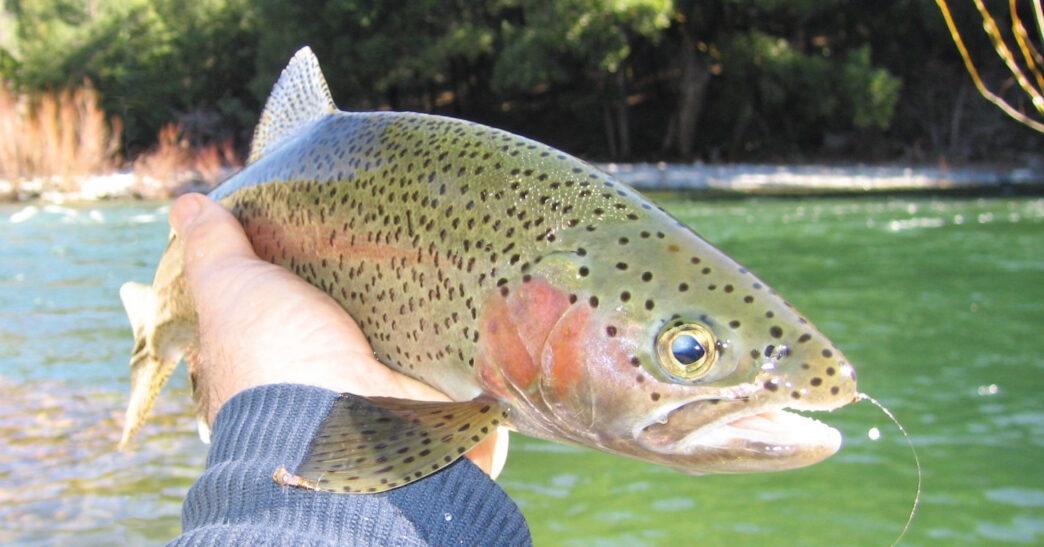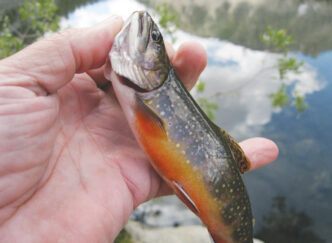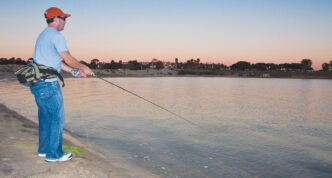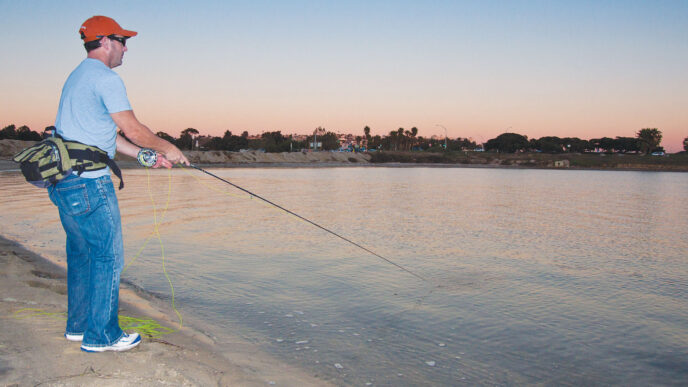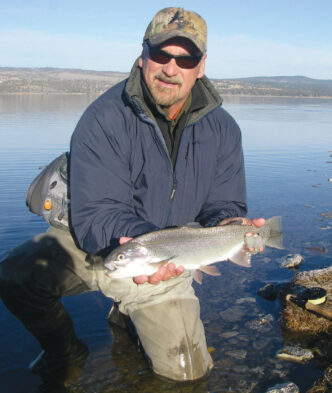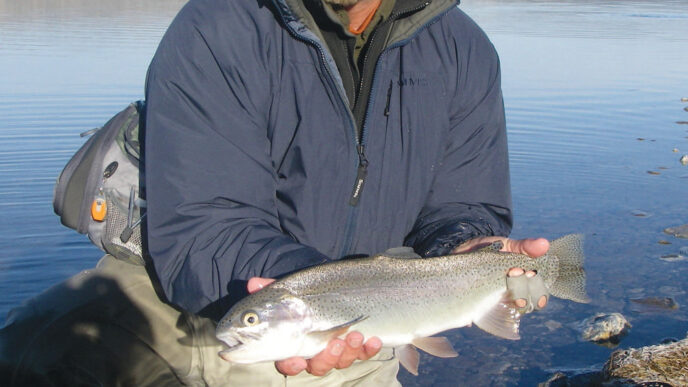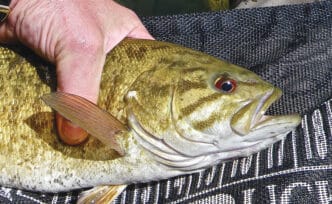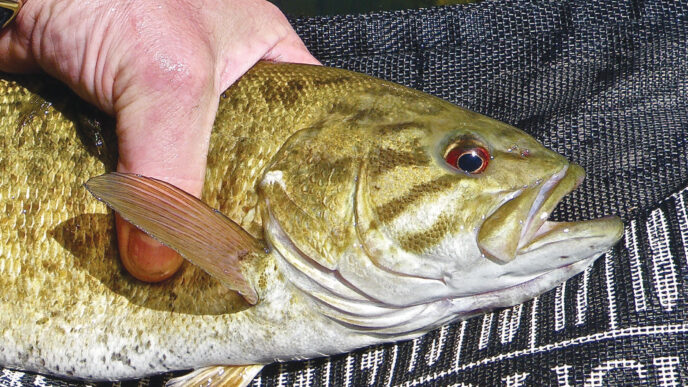The coming of spring to Mount Shasta means the cold, arduous pursuit of winter steelhead is replaced by the warm, sunny, joyful pursuit of trout. The rivers feel as if they are refreshed and renewed, the trees and shrubs bud and bloom, and the birds chirp at us as they nest in anticipation of new arrivals.
Bugs have started hatching, and fly boxes have been refilled with old favorites and perhaps a few new patterns. Hungry trout have returned to their haunts to await the beginning of the annual feast, and the savvy angler knows where to find them — perhaps better yet, how to catch them.
I live in the town of Mt. Shasta, in the heart of the finest fly fishing that the state has to offer, and following is a brief survey of my favorite springtime haunts within an hour’s drive of my home. I suggest my favorite time to be on the river, along with the technique I most enjoy on each of these rivers and perhaps a few flies that have been useful. This is not intended to be a prescription for success, only an offering of delightful springtime possibilities that I hope you will enjoy.
The Lower Sacramento River: March
My spring season usually begins in March by drifting the Sacramento River downstream of Keswick Reservoir. In the 50 years I have spent chasing trout with a fly rod, the best day of dry-fly fishing I have experienced occurred on March 22, 2002, on the lower Sac, and I have been searching for another one like it ever since.
I had not planned on dry-fly fishing that day, because the lower Sac is best suited for indicator nymphing. I was rigged with a bobber and two nymphs, one a size 16 olive-and-brown LaFontaine Emergent Pupa and the other a Beadhead Peacock and Brown Soft Hackle to imitate the hatching spring caddisflies. I was enjoying some success when I noticed a pod of sizable fish porpoising.
I removed the indicator, the split shot, and the beadhead nymph, and after applying some Dry Shake, cast the LaFontaine Emergent Pupa as I would a dry fly. I hooked a hefty, hot rainbow. A few more casts brought a couple more fish to the emerger, but I was having difficulty seeing it sitting in the surface film in the dull, gray light, so I switched to Ralph Cutter’s higher-floating E/C Caddis and was again into fish.
The fishing became so good that it proved not to be much of a challenge, so I decided to target just the largest fish. I waded up and down the flat, carefully observing rise forms, and I hooked and landed a few more chunky rainbows. I ended my day with fish still rising all around me when, on three successive casts, I played and landed three fish all over 20 inches. I know what you are likely thinking, but that’s my story, and I’m sticking to it.
I have returned each season since and have yet to experience the same success. I typically side-drift nymphs under an indicator from a boat, like everyone else, enjoy the warm weather, the good company, and often catch fish, including some large ones. You can be sure I always keep a watchful eye out for rising trout, though, hoping to have the opportunity to repeat my magical spring dry-fly day.
The Pit River: March and April
Trust me, the Pit River is not for everyone. It is the most difficult river to wade I have ever experienced. Its banks are filled with poison oak, and they host a healthy population of rattlesnakes. But if you are willing and able to suffer these challenges, you could enjoy the highest catch rate that the Mount Shasta area offers. Particularly in the spring, you are also likely to enjoy some solitude.
Most of the Pit’s trout are thick bodied, acrobatic wild rainbows that measure in the teens. The water clarity is typically low — perhaps two to five feet — compared with the rivers in the Pit’s sister watersheds, the McCloud and upper Sacramento. This makes approaching and casting to these wild fish without spooking them considerably easier, particularly for less-accomplished anglers. In other words, it is an ideal place for the athletic intermediate fly fisher.
While most folks fish nymphs under indicators on the Pit, I prefer to fish without an indicator and to high-stick nymphs whenever possible. This technique requires a close approach to fish and casting a short line, but as I mentioned, the colored water masks the angler’s approach, making this easier. The low water clarity makes the fish grabby, because they have little time to inspect flies, requiring them to make quick decisions that often favor the angler. I also find that the direct contact with flies that this technique offers helps me keep them from snagging the bouldery substrate and prevents the resulting frustration that comes with lost gear.
For me, high-stick nymphing is the most meditative of all angling techniques. It makes me feel like an ancient hunter. I am constantly moving, on the prowl, testing every nook and cranny, becoming intimate with all of the potential lairs of the trout. Most of the time, I detect the take by a quick movement of the line. I also find a few bonus fish that hook themselves as the flies come tight and lift off the bottom at the end of the drift. On occasion, a fish will appear when I set the hook for no apparent reason other than a feeling, and I’ll find a wild creature attached to the end of my line.
The Fall River: May
Springtime on the Fall River offers technical spring-creek dry-fly fishing at its finest. With Mount Shasta as a backdrop and fish rising in its reflection, life does not get much better. The Fall River opens on the last Saturday in April, and for several years running, it was the place where I welcomed the new trout season.
We would typically stay at Rick’s Lodge on the upper river and motor up or down to a spot where we expected to find pods of fish rising to Pale Morning Duns and Blue-Winged Olives or, on rare occasions, to larger mayflies. Unlike the freestone streams in the area, which can be blown out by high, off-color water in the spring, the flows on the Fall River are steady and reliable. Hatches in the spring typically start anywhere from midmorning to late morning, allowing a leisurely breakfast and a casual start. On the best days, the hatch can last late into the afternoon.
The trout are highly educated (mostly rainbows), quickly become conditioned to angling pressure, and are usually difficult to fool, but in the spring, they have been feeding unmolested since the previous November, so they are much more aggressive and eager than you’ll likely find them later in the season. Long leaders tapered to 6X are still the norm, and delicate, accurate casts help. A box filled with a variety of patterns, including high floaters, emergers, cripples, and floating nymphs will keep you occupied searching for the fly de jour. Many fine tyers, including Andy Burk and Bob Quigley, have used Fall River as a testing ground for their spring-creek patterns.
Access issues make this a floating fishery. The standard drill is to find a flat, anchor your boat at the upstream end of the weed beds were the fish are holding, and cast downstream and slightly across to visibly rising fish. You then flick line out of the rod tip, which drifts the fly into a trout’s feeding lane in a process that has been dubbed “the Fall River twitch.” It is considered the most effective technique to avoid spooking these creatures. Once fish are caught or spooked, lift the anchor and reposition the boat downstream so that a new pod of rising fish can be targeted. It is pleasant angling in a pastoral setting, and it can be very satisfying to the soul.
Rick’s Lodge has since changed hands and names, and the river has suffered siltation, which has spoiled some of the best runs. Anglers usually either launch at the CalTrout access off Island Road or stay at a lodge or vacation rental on the river that offers boat rentals or launching facilities. As spring turns to summer, the evening Hexagenia limbata hatch gets going, but that story is best saved for another time.
Hat Creek: May
The wild-trout section of Hat Creek is perhaps the best-known spring-creek angling venue in the Shasta area, judging by the number of anglers found at the famed Powerhouse 2 run on the opening day of the season, which, as on the Fall River, arrives on the last Saturday in April. It features reliable hatches and flows similar to the Fall River’s, but Hat Creek is a walk-and-wade destination, rather than one that must be fished from a boat. I do not crowd well while fishing, so I do all I can to avoid this gathering at Powerhouse 2.
Early in my guiding career, while leading a trip for Chico State, I discovered that the majority of the Hat Creek crowd is a fair-weather crew. Our trip was planned in the middle of May, as the semester ended, and due to some foul weather, we had the place to ourselves. The more important discovery was that the mayflies on Hat Creek were particularly fond of this weather, and the hatches were strong for the best part of the day. Seeing the little buggers in the flat, gray light was another matter, which brought about my greatest discovery of all. The big Green Drakes like this weather, as well.
While Green Drakes are only a minor hatch in this part of the world, don’t miss the few bugs that show. Trout don’t miss them. They consider this insect a bonbon and will rarely let one pass by. While a Parachute Adams will sometimes fill the bill, I prefer extended-body paradun patterns. My favorite of all, however, is Andy Burk’s original Green Drake Cripple, which features a high-floating elk-hair wing and a marabou abdomen/tail that sinks into the film.
Burk’s Green Drake requires less maintenance to keep it floating than other cripple patterns that I have fished, but more importantly, it has fooled the largest fish in the river. It is also substantial enough to support a beadhead dropper, such as a small Pheasant Tail, Mike Mercer’s Micro May, or Hogan Brown’s S&M, to imitate small mayflies and increase chances for a hookup while prospecting water when the hatch wanes and fish are not showing.
So now, when the sunny days of spring are interrupted by a forecast for clouds and drizzle, I no longer fret that my local freestone will be blown out. I just pack my rain gear and head to Hat Creek for some delightful dry-fly fishing and possibly solitude, as well.
The McCloud River: May and June
I feel fortunate to live so close to the McCloud River. It is one of the most magical and scenic trout streams I have ever experienced. It has it all. It’s surrounded by pristine evergreen forest with blooming dogwoods and tiger lilies in the spring, in a remote canyon with emerald pools reflecting like gems. The trout are the most famous on the planet, wild rainbows known for their aggressiveness and hearty fight. These remarkable fish were cultivated and transplanted to other continents and hemispheres over a century ago.
Living near such a river allows some intimacy, and learning the moods of the McCloud provides opportunities that visiting anglers can merely glimpse. One of the difficulties of planning an extended visit in the spring is predicting the flow regime. The lower McCloud is technically a tailwater, erupting from a pipe at the base of the McCloud Reservoir dam much like flows from an open fire hydrant, and the flow controls are at the fingertips of a power company.
Predicting flows is further complicated because a large portion of the water behind the dam is siphoned off through a tunnel, eventually dropping into the Pit River, where its energy is used to turn turbines. This can result in artificially good fishing on the McCloud, with low flows in the early season, even in a big-water year such as we had in 2011, when all the other North State freestones were blown out. Unfortunately, this also means that the dam can spill and flows become unfishable, sometimes within an hour, with little or no warning, spoiling a visiting angler’s trip.
Day-tripping into the McCloud requires a quick drive on pavement, followed by a mile of dirt to Ash Camp below the dam (no amenities beyond a pit toilet) or eight miles of bad dirt road to the Ah-DiNa campground (18 improved sites and running water) or to the Nature Conservancy Preserve (10 rods per day, 5 by reservation, 5 walk-ons). The remainder of an angler’s day is spent hiking angler’s trails and walking and wading the various pools, runs, pockets, and plunges perfectly designed to harbor wild trout.
One of the greatest gifts the McCloud offers is the option to find water suitable for any method an angler prefers, with nearly every technique proving successful at one time or another. The majority of folks these days fish nymphs under indicators, which is reliable, though many have also discovered that nymphing without an indicator, particularly nymphing the pocket water, can produce when little else does.
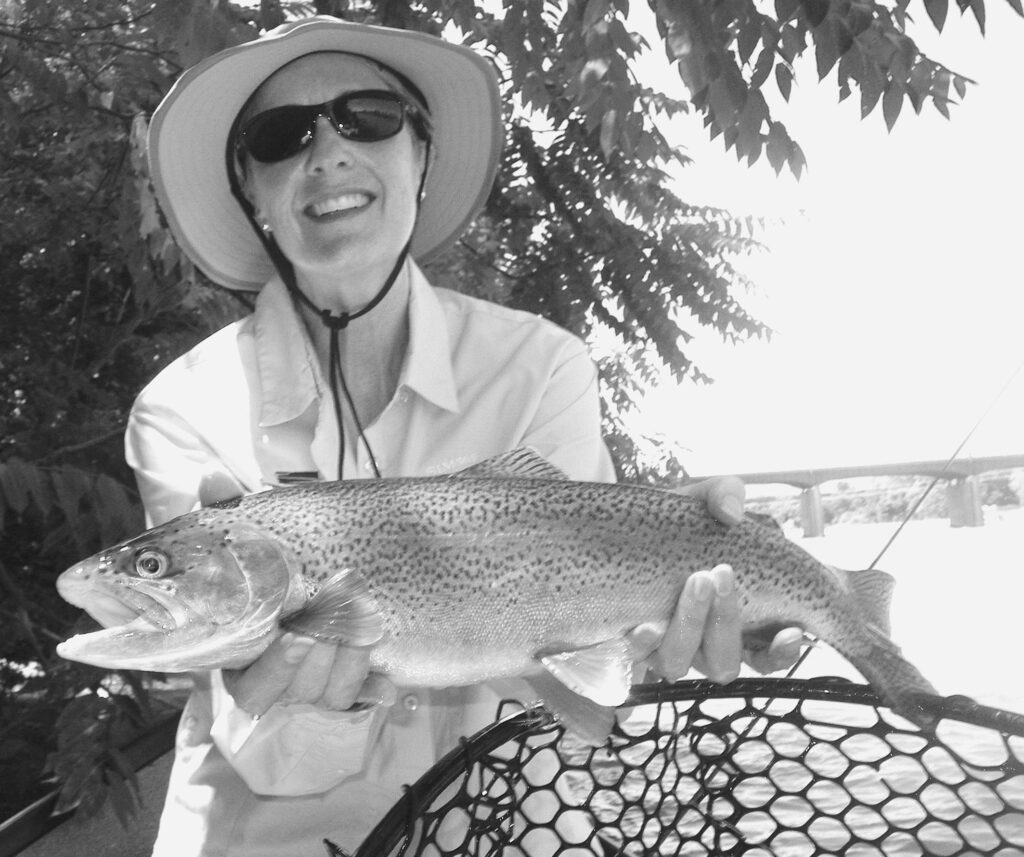
When the hatches are on and the fish are looking up, there is no place I would rather be. Spring hatches include Golden Stones and a few Salmon Flies, several species of caddis, and almost every mayfly that hatches in this part of the world. Standard patterns work well in the spring, because the fish are not particularly fussy. Between hatches, fishing an attractor dry through the faster water, particularly with a small beadhead dropper attached, will find more fish than most folks expect, including some surprisingly large ones, measuring into the upper teens and twenties.
When left to sample the river on my own, I find myself more and more drawn to the McCloud’s other trout. Brown trout were transplanted there over a century ago, filling the niche left by bull trout, which were extirpated when the dam was built in the middle of the last century. These fish can grow to sizes no longer measured in inches, but in pounds, some of them large enough to change an angler’s life forever. Covering as much water as possible (fun in its own right) with a sinking line and outlandish streamers provides perhaps the surest opportunity for encountering these elusive creatures. Pursuing such fish can become a passion that has ruined better men than me.
The Klamath: Late May and June
Wild steelhead on a dry Salmon Fly — need I say more? OK: bring the kids and novices. The upper Klamath River below Irongate Dam has a Salmon Fly hatch that draws a few holdover steelhead to the surface each day, to the delight of beginners and seasoned anglers alike. To be honest, the vast majority of the action is a “smoltathon,” producing wild and hatchery juvenile steelhead in the 9-to-14-inch size range.
Starting near the end of May or in early June, for 10 days or more each season since 1998, when I moved to Mt. Shasta, the dry-fly fishing has been silly good on this piece of water. High flows early in the season can blow it out, but more often, high water temperatures late in the season make catch-and-release angling unwise because of the resulting fish mortality.
Angling on this stretch of the Klamath is best done casting to bank-side cover from a drift boat, because the wading is difficult and treacherous, and bank access limited. The standard dries are Stimulators, Sofa Pillows, and Foam Stones tied on size 4 or 6 long-shank hooks attached to 7-1/2-foot 3X leaders. When the topwater action wanes, tying a beadhead Copper John or Ken Morrish’s Iron Sally to the bend with 2 feet of 4X tippet will keep you into fish. I suggest you visit the Klamath this season. Enough said.
The Upper Sacramento River: June
The upper Sacramento River, above Lake Shasta, is one of the last rivers in our area to drop into shape during high-water years. The good news is that it can fish pretty well even when the water is high, particularly in the spring. Most visitors consider 1,000 cubic feet per second on the upper Sac to be high, while locals, who are more familiar with where the fish hold in high water, might consider flows over 3,000 cfs high.
As on other freestone streams in the area, many people fish nymphs most of the time, with an indicator and some split shot. However, this is the river where in the middle of the last century Ted Fay popularized nymphing using a tight-line or high-stick method with heavy “Bomber” flies and without an indicator, which is very similar to today’s Czech nymphing craze. This technique remains popular and effective, but is better suited to pocket water and low flows.
My favorite technique on the river in the spring, as well as during a good part of the rest of the year, is casting a modified version of the hopper-copper-dropper rig. I typically attach a Golden Stone, Salmon Fly, Green Drake Paradun, or Parachute Adams to a 4X 6-foot leader. That’s the “hopper.” I tie a Copper John, Ken Morrish’s Iron Sallie, or a tungsten beadhead nymph about 2 feet off the bend of that fly. That’s the “copper,” and I tie a small nymph 10 inches off the “copper” fly — the “dropper” — with 5X tippet. This rig can be cast like a normal dry-and-dropper rig if you take care to cast controlled, open loops. I have taught beginners to do this, provided they limit their casts to a distance of 20 feet or less.
In the heavy flows of spring, it can be a challenge to keep your dry flies floating. I have started to dress my flies in a way that has helped tremendously. I first take some liquid floatant and apply it to the fly before it gets wet. I then apply floatant to the entire leader except the tippet. Finally, I apply some desiccant to the fly to help repel water. After that, I apply only desiccant, never again dressing the fly with floatant. I did not fully understand why this worked so well until reading Henry Kanemoto’s article “What Floats Your Fly?” in the January/February 2012 issue of California Fly Fisher, which I highly recommend.
I try to cover a lot of water using this three-fly rig, including all the classic runs, and am often pleasantly surprised by the number of chunky rainbows that are looking up, even an occasional whopper. Being able to false cast and present the flies rather than chucking and ducking with an indicator rig brings me additional pleasure. And if I am not getting the results I like, it is easy enough to pop off the dry, tie a knot, add a split shot and an indicator, and go through the run again
This has been a gentle recollection of places, times and techniques that have given me pleasure over the years, not a prescription for your fishing. My hope is that you found something of interest and will have the opportunity to enjoy it on your next fishing trip.




